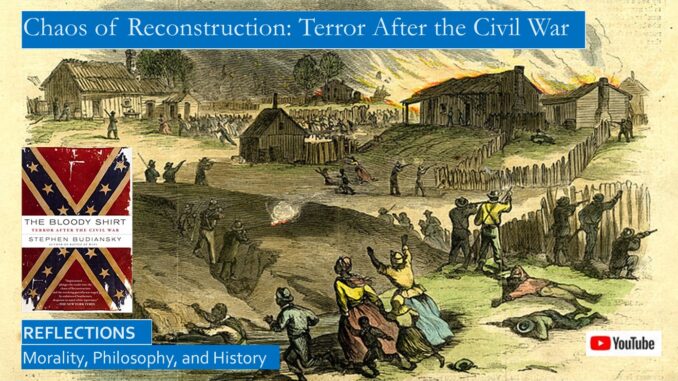
What can we learn by reflecting on the severe difficulties the Union Army Major Merrill faced when attempting to protect the civil rights of newly freed slaves in the Confederate South?
We reflected on the story in the book, Bloody Shirt, Terror After the Civil War, to answer a very personal question, How can so many of my Christian friends seem to embrace the false narratives of Fox News and Donald Trump, valuing cruelty over compassion? What are so many white Christians so against what they call WOKENESS, against the Black Lives Matter ethos, against Civil Rights, against basic kindness?
Script for this video, with more Amazon book links: https://www.slideshare.net/BruceStrom1/chaos-of-reconstruction-terror-after-the-civil-war
YouTube: Chaos of Reconstruction, Terror After the Civil War: https://youtu.be/ZEX050eTn38
YouTube: Terror During Reconstruction, White League Confronts General Longstreet and Union Army: https://youtu.be/bF3w2RrSaM0
One answer is in this book, it is not a history of the forest of Jim Crow and Reconstruction, and we have many videos on this broad topic, but rather it is a story of individual communities where Southern citizens, including many white Christians, were so quick to support the violent terrorism of the Ku Klux Klan night riders in the dark days following the Civil War.
ORIGIN OF THE PHRASE, BLOODY SHIRT
Where does phrase, Waving the Bloody Shirt, originate? On one dark midnight the Ku Klux Klan night-riders galloped to where Allen Huggins was staying, they sought to bully and intimidate Huggins, who was the school commissioner, so he would cease and desist from educating the negro. They beat him with a strap nearly a hundred times, kicked him, and pointed their pistols at him and threatened to shoot him.
Our author, Stephen Budiansky, writes that “Huggins was whipped so ferociously that he could barely walk for a week or two, so ferociously that in a burning anger that overcame any fear of his own death he traveled to Washington to testify before Congress,” returning with a “deputy marshal’s badge, determined to arrest every man he could lay his hands on who had been a part of the KKK murder and terror.” His bloody shirt was waved on the floor of Congress in a speech condemning the Ku Klux Klan and their reign of terror, leading to legislation enabling the US Army to finally put down this terrorist movement.
POST CIVIL WAR POSTING OF MAJOR MERRILL
We will focus on the career of Major Merrill, who showed considerable bravery in his actions during the Civil War, some of his exploits are told by our author. Before his first post-Civil War task he was incredulous of the stories told of the Ku Klux Klan and other white terrorist groups. Our author writes what Major Merrill told his commanding officer: “The newspaper stores were incredible: tales of shadowy bands whipping and beating leading Republicans in strange nighttime ceremonies, of schoolhouses set ablaze, Republican officeholders forced to resign on threat of death, entire towns seized by a thousand disguised men taking up position in eerie silence and stringing up a dozen Negroes who had dared to enlist in the state militia.”
The chilling reply to Major Merrill was that “when you get to South Carolina you will find that the half has not been told you.”
The militia commanded by Major Merrill arrived in the neighboring town on Saturday night. The train to their post in Yorkville, in York County in South Carolina, was scheduled to depart on Sunday morning, but the Sunday train never arrived. When the train did arrive on Monday morning, the soldiers were told the track had been damaged, delaying the train for a day.
When they pulled into Yorkville later on Monday, the “pretty tree-lined streets of Yorkville were quiet. It was a town of fifteen hundred people, a number of elegant Georgian and Greek Revival houses, several hotels, some palatial,” “grocery stores, specialty shops, doctors’ and lawyers’ offices,” and “a row of substantial church buildings, Presbyterian, Methodist, Baptist, Episcopalian, the last boasting a square Gothic bell tower.” There were many churches in the peaceful town of Yorkville.
Later that day they learned that the day before there had been a disturbance, a band of a hundred hooded men had set upon Rose’s Hotel, looking to hang Edward Rose, the Republican owner. His hotel was ransacked, and Edward fled out the back window, fleeing all the way to Canada.
A few days after their arrival, leading citizens of the town called on Major Merrill, assuring him that they were opposed to this violence. But what didn’t make sense was that the damage to the rails were not extensive, the rotted ties had not been disturbed, only one rail had been leaned up against the tree, rails had not been wrapped around any trees as was often done during the Civil War. Once the Sunday disturbance was over, it took less than an hour to fix the tracks. The incident was not mentioned in the paper. Major Merrill learned from an informer who conspired to run Edward Rose out of town: the railroad men, the sheriff and deputies, the newspaper editor, nearly every white in town.
These leading citizens met with Major Merrill, they said they were opposed to violence. They pointed to an editorial in the local Enquirer that denounced the violence, doubted that the violence would recur, and that any further violence would be surely put down by the power of the Federal Government.
Who was to blame for this outrage? The editorial pointed fingers, saying that although the violence was not justified, that “the negro radical government of this state is responsible for all the evils that are upon us.” The negroes had refused to vote with the segregationist Democrats, “instead the black vote was massed against the white man.”
The retaliation on Sunday afternoon was inevitable. “Threatened by the bayonets of our former slaves, insultingly and defiantly marching by night and by day” “through the peaceful country and in the thronged streets; tormented to madness by a thousand acts of injustice and tyranny; retaliation must and has commenced. The guilty perpetrators of crime and outrage have been overtaken and scourged. It was the result of their aggression.”
The editorial “Resolved, That the existing negro government of South Carolina is a reproach to the civilization of the age; a stain upon the manhood of an intelligent and gallant people who have so long and so patiently endured and submitted to be ruled by former slaves. We are tired of it and will exert every legitimate and constitutional means to effect a change.”[1]
For about three weeks there was peace in the county, and all the townspeople were friendly to Major Merrill, but then the Ku Klux Klan showed up at a plantation searching for a negro man, who fled, so they severely beat his negro father instead for not properly bringing up his son. Many negroes knew who the guilty white men were, they were eager to inform our major who they were, but they refused in fear for their lives to testify in court.
Major Merrill says that he knew that the “Ku Klux Klan is much greater in numbers than is commonly supposed, and that a large number of the most respectable people in the county are more or less intimately connected with it. The debauched sentiment of the old slave-holding communities sees no great offense in whipping a negro for being a radical. The old sentiment is rife, where differences of opinion are settled by killing the man who dares to disagree with them.”
Major Merrill got to work documenting crimes recently committed by the KKK, including four hundred whippings, six murders, and several schoolhouses and black churches that had been burned down. He had solid proof against eight men, and circumstantial evidence against many more. Everyone knew in this small town who had done these deeds, everyone except for the whites who served on the coroner’s jury, who were mystified.
Then the KKK night riders brazenly lynched Jim Williams, the negro captain of the local state militia, they proclaimed that he was being lynched for voting for the radical ticket. When his wife heard strangling noises, she opened the door and begged them not to harm her husband, they told her to shut the door and put her children to bed. Jim Williams was found swinging from a pine tree.
Major Merrill learned when the KKK was next planning to ride to terrorize the blacks of the county. He asked the sheriff if he could accompany his troops to catch these night riders in the act, so he could arrest them. The sheriff agreed, but then the sheriff’s feet went cold, he made excuses, and declined to participate.
How could our brave Major Merrill combat this evil? He devised a plan, he asked one of the town’s prominent lawyers, a former Confederate colonel, to call a meeting of several dozen of the town leaders to discuss what could be done, fully expecting that several of them were also leaders in Ku Klux Klan themselves.
Our author recounts, “these leading town leaders came to his office at eleven o’clock on a Saturday morning, and the major proceeded ever so politely to make it clear that he knew everything they were up to.” “He described in minute detail the recent KKK raids, making it clear that they could do nothing without him learning of it, implying strongly that there were informers in their own ranks, and they could trust no one.”
He bluffed, saying he was expecting to hear from President Grant that he was suspending the writ of habeas corpus in the town, authorizing him to put under military arrest the guilty parties. Then he convinced them to place in the newspaper a notice signed by several hundred leading citizens of the town denouncing the violence and terror being spread by the Ku Klux Klan.
This neither shamed nor dissuaded the good citizens of Yorkville, South Carolina. The violence continued, Major Merrill added to his evidence file, more beatings, some threatened lynchings. Major Merrill telegraphed his superior for permission to arrest the members of the KKK, he received no answer. Not only were all those who worked on the railroad conspiring with the KKK, so also were the telegraph operators, and the leaders of the KKK knew the contents of any telegrams sent and received by our good major.[2]
SOME JUSTICE SERVED AT LAST
Major Merrill sent letters to his superiors in the army describing his frustrating and futile attempts to safeguard basic civil rights, due process under the law, and simple justice in York County, on behalf of the freed slaves. These appeals and likely many others went up the chain of the command.
The colored South Carolina Republican congressman courageously visited York, Congress held hearings on the civil rights abuses in York County and likely other localities as well. One noteworthy witness was the bravest, most helpless, and most sympathetic witness imaginable. Our author recalls, “It was the testimony of Elias Hill that cast a hush over the room,” his life was “a latter-day story of Job. He was a cripple, with shriveled legs no bigger than a child’s, an arm drawn up and perpetually frozen in rheumatic pain. He was carried into the hearing room and setup up in a chair.” “When he began to speak it was in a strong and melodious voice, the voice of a preacher.”
“The crippled boy learned how to read and write, became a schoolteacher to the other children, and for ten years had been preaching” in a Baptist Church. His family and the colored people who lived nearby helped care for him, helped him eat his meals, and carried him everywhere he went.
One midnight our shriveled little cripple was bullied by the KKK night riders. “Where’s Elias?” shouted the white-hooded men. Our author relates, “a rough hand” “grabbed his withered arm and threw him on the ground outside. The men then pummeled him with their fists and a pistol butt, jerked his painfully atrophied legs, ordered him to pull up his shirt up and horsewhipped him eight cuts on his hip, and finally put a leather strap around his neck and said they were going to throw him in the river and drown him.” They demanded he renounce the Republican Party and halt his preaching, but finally they relented, permitting his sister-in-law to lay him on his bed, “giving her a couple of parting lashes with a leather strap.”
This was excerpted from his testimony before the committee. These were some of his responses to the cross examination:
Question: You do not feel very kindly toward the white race?
Answer: I am afraid of them now.
Question: Frightened of them?
Answer: Yes, sir. I have, and show goodwill, love, and affection toward them, but I fear them.
The good citizens of Yorkville insisted they would enforce their laws, so a grand jury was called, and the judge informed the grand jury that it was their duty to listen to the testimony of Major Merrill. Our author tells us, “the whole town was in on the joke, and decided to help it along. Many prominent citizens of Yorkville singed a petition to President Grant declaring that no outrages had occurred in their county for the past month, although Merrill’s reports showed that there had been at least ten incidents, including one murder.”
The grand jury proceedings were compromised, informers informed Major Merrill that a third of the grand jury members and three trial justices belonged to the KKK, and two grand jury members were accessories to KKK murders. There were whisperings that the grand jury would prove that the War Department had been deceived by Major Merrill, but he called their bluff by providing evidence for over a hundred violent crimes and murders.
The next month General Grant, under the provisions of the recently passed Enforcement Act, “ordered the Ku Klux Klan to disperse within five days and turn in all weapons, disguises, and paraphernalia; the federal government could suspend the writ of habeas corpus and send the army to make arrests on its own authority.” Shortly afterwards, an additional infantry and two calvary divisions arrived in Yorkville to assist in enforcing this law, and the habeas corpus was suspended in nine counties in South Carolina, including York County.
Our author tells us, “two days later Major Merrill sent squadrons of calvary galloping across York County to arrest eighty-two men, almost simultaneously and without incident. He made a point of sending them in broad daylight, arresting the prisoners in town or at their places of work; there would be no midnight knocks on doors, no accusations of men being torn from their families under cover of darkness.”[3]
HUNDREDS CONFESS, MOST ARE PARDONED
These prisoners overwhelmed the second and third floors of the local jail, there was not enough room in the cells even with most prisoners sleeping on the floor, many were compelled to sleep in the corridors.
Our author writes, “The locals called confession ‘puking.’” Another five hundred men puked, turning themselves in, while several hundred, including many ringleaders, fled the county. Many men who agreed to testify in court insisted on being arrested so it would look like their testimony was forced. Major Merrill hired a stenographer who had difficulties recording all the testimonies. So many men turned themselves in that our major had no choice but “take their confessions and send them home on their own parole, holding only those who confessed to the most heinous crimes.”
Our author continues, “The prisoners were transferred to Columbia, South Carolina, for trial in United States Court.” “In Columbia, the prisoners were out-and-out heroes. The ladies of the city called regularly with sparkling conversation; the reverend doctors and students of the theological seminary came with words of solace,” which meant that the white Christian clergy condoned Ku Klux Klan terrorism; and a famous fire-eating secessionist “came with a five-gallon keg of beer and stirring oratory: “Well, gentlemen, we are all in jail in South Carolina, the only difference is, you are under shelter, and those of us who are on the outside have to dodge the storm as best we can.”
When the trial commenced, “most of the defendants pleaded guilty; most of the leaders had already fled.” The Ku Klux Klan constitution was read into evidence, “it swore its members to secrecy on penalty of death; swore them to oppose the ‘radical party;’ swore them to fight for the constitution ‘as bequeathed to us in its purity by the forefathers,” denying the validity of the Reconstruction Amendments guaranteeing blacks freedom, due process under the law, and the right to vote.
Courtroom testimony was graphic and compelling. Our author writes, “colored witnesses told of being whipped and threatened for having voted the Republican ticket; ‘damn you, we’ll make a Democrat of you tonight,’ his assailants told one man as they beat him. A colored woman described her rape in such graphic terms that the court reporter noted that it was ‘of too obscene a nature to permit of publication.’”
When the guilty defendants lined up to receive their sentencing, our author states that “Judge Bond was indignant, but his options were limited.” Judge Bond addressed them, “Some of your comrades recite the circumstances of a brutal, unprovoked murder done by themselves, with as little apparent abhorrence as they would relate the incidents of a picnic, and you yourselves speak of the number of blows with a hickory, which you inflicted at midnight upon the lacerated, bleeding back of a defenseless woman, without so much as a blush or a sign of regret.” There were so many defendants that most were either fined up to a hundred dollars while some were sentenced for few months.
While the trial was proceeding, officials in Washington were tiring of the intransigence of the hundreds of defendants. They had other priorities; most Northern whites were prejudiced towards blacks. Our author notes, “the army commanders were antsy to get the cavalry back to its business fighting the Indians out West, to get out of the degrading business of acting like so many police constables down South. The United States courts couldn’t possibly handle the hundreds of pending cases anyway, not with one judge riding the circuit and funds so short that the district attorney couldn’t even hire a stenographer.”
This lack of enthusiasm led to many defendants being pardoned, only serious cases like murder would be tried and/or sentenced. Troop morale broke down in Yorkville after many soldiers were sent West, eventually the rest of the troops were pulled out. Major Merrill was given a year’s sick leave, then was sent to Dakota for a few months, but then transferred “to Louisiana, where a real war had broken out,” a war that was also being fought by former Confederate General Longstreet, formerly Civil War hero, but whose popularity had plummeted when he served in the Federal Army battling the forces of white supremacy.[4]
In our next video we will discuss the next Reconstruction Era posting of Major Merrill, and how he and the former Confederate General Longstreet confronted the White Leaguers, another white supremacist terrorist group similar to the KKK, in Louisiana.
CONCLUSION, DISCUSSING THE SOURCES
What did I realize when reading this remarkable story of the career of Major Merrill? I was reminded by a Rotary talk I heard by Stetson Kennedy, who infiltrated the Ku Klux Klan in the 1950’s. He points out that in its heyday, when a large chunk of the young males were members of the KKK, many joined to be part of the group, it was a social outlet and a way to get away from the nagging wife. This partially explains why on most of these night rides, they usually beat and terrorized the blacks they bullied, murders and lynchings only happened on occasional midnight rides.
https://en.wikipedia.org/wiki/Stetson_Kennedy
We should also realize that many Northern whites were prejudiced against blacks, and that the Reconstruction Amendments protecting the civil rights of blacks were emasculated by the Southern dominated Supreme Court after the end of the Reconstruction Era, and that indeed, the reason why Reconstruction Amendments were ratified because the North compelled the Southern states to ratify them as a condition for readmission into the Union, ending their military rule under the United States Army troops.
We have other videos discussing how broad swaths of white Southerners and Christians wanted to deny that freed blacks were human beings worthy to associate with white people. There are historical memories of white Christians attending lynching festivals that are not only public, but have been publicized, and are conveniently scheduled after Sunday morning church services. Many whites do not want to hear that there were over ten thousand lynchings where mostly innocent blacks were hanged and sometimes burned and their corpses hacked into pieces and sold as souvenirs.
There was also widespread use of the peonage statutes, where innocent blacks were arrested for vagrancy for standing on the street corners and were impressed into involuntary labor under atrocious and sometimes fatal working condition, which was really slavery under another name.
Plus, we have the general histories of the Reconstruction and Jim Crow Redemptionist eras, by the renowned author and Civil Rights activist, WEB du Bois, and also a summary of the Yale Lectures on Black History of these eras.
https://youtu.be/JeRCM4PAqPk and https://youtu.be/f5nPNnvDBCY
[1] Steven Budiansky, The Bloody Shirt, Terror After the Civil War, Chapter 14, pp. 114-119.
[2] Steven Budiansky, The Bloody Shirt, Chapter 15, pp. 120-126.
[3] Steven Budiansky, The Bloody Shirt, Chapter 16, pp. 127-135.
[4] Steven Budiansky, The Bloody Shirt, Chapter 16, pp. 137-145.

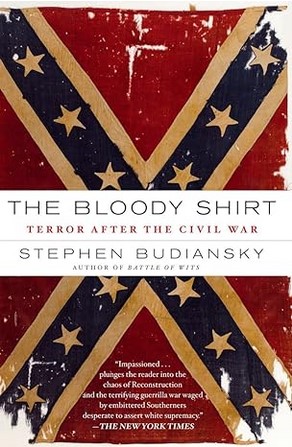
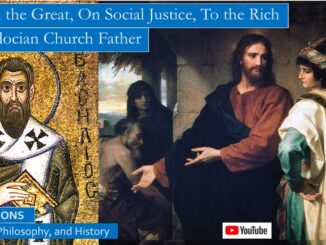
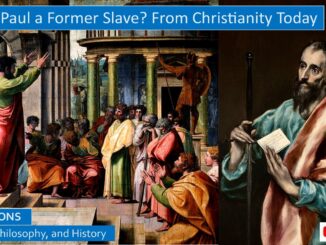
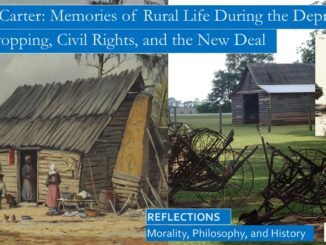
1 Trackback / Pingback